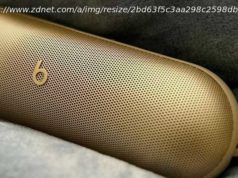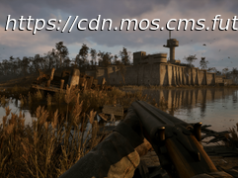A Dutch company is developing a floating dairy farm, which they hope to use as a proof-of-concept for future agricultural systems. The farm will use automated cleaning and milking robots, while recycling waste into fertilizer. Later, they hope to include crops and other livestock.
In the next three decades, the global population is expected to grow by more than two billion people. That could be a problem. We already fail to feed the roughly seven and a half billion people currently living on the planet, so we’ll need to initiate entirely new agricultural systems to accommodate more.
Soon, a Dutch company will begin testing a system they think could help provide locally grown food to coastal communities: a floating farm. For centuries, the Netherlands, one of the most densely populated nations in the world, has staved off encroaching seawater through innovative engineering techniques, while making use of limited land to feed its citizens. The floating farm idea combines these two Dutch specialties — maritime engineering and agriculture.
The first floating farm will focus on dairy cows, in particular a Dutch breed called Meuse-Rhine-Issel, but Beladon, the group behind the project, hope to expand to include crops and other livestock. Intriguing as the concept may be, it’s not clear that it’s environmentally beneficial, lucrative, or scalable.
We spoke with Minke van Wingerden, co-owner of Beladon. She described a partially automated operation, where robots do the milking as cows are treated to a “ bougie ” experience. This interview has been edited and condensed for clarity.
Digital Trends: How did the idea for a floating farm first com about?
Minke van Wingerden: My husband came up with the idea. Seven years ago he started Beladon, a company that designs floating structures. He was busy with a project in New York in 2012 when Hurricane Sandy hit and Manhattan was flooded. He realized it’s important to produce fresh foods nearby cities because after two days shelves in the shops were empty.
It wasn’t the smartest idea to start with a floating dairy farm because cows are very big and curious, and they move together, so the structure has to be fairly stable. But, in the Netherlands, we’re used to floating structures and building on water. In our project, maritime technology and agriculture technology come together. That combination makes this project so interesting for the Dutch.
Can you describe the layout of the structure?
Well we are going to use a rubber floor that is a little elastic, so it’s good for the cows’ bones and joints. It has small canals, which we are going to clean with a manure robot. It’s easy to clean and then the robot takes away the manure, and it immediately separates the manure and urine. That’s important because when you separate that quickly it has less smell.
Where does the robot take the waste?
The floating farm has three layers. The concrete layer at the bottom. Then the first floor, or the process floor. And the cows are on top. The manure goes from the top to the floor beneath, where we process the manure.
We split the manure and urine, then dry it and sell it the city as a fertilizer for grass or plants on your balcony. We are also going to use it for the cows so they can lie on it. It’s a raw material and they like lie on it.
You currently plan for 40 cows. Have you considered adding more to the herd?
This is now a private project, so we have zero subsidy and limited money. We made it as small as possible. For us, animal welfare is very important.
Cows need more space than in a regular stable, but we think that now they have about one and a half times more space than in a regular stable, so they will feel fine. This small floating farm, we call it our living lab, because this is how we are going to show the world that we can make it happen.
How much do you plan to invest in the project?
About €2.6 million ($3 million). But we think it would be much more interesting to make it bigger and start with about 100 cows.
Who will be milking the cows?
We have hired a real farmer, who is the son of a farmer from the northern part of the Netherlands. Now he can live in the city and be a farmer. In the Netherlands, farmers have a lot of troubles with succession. A lot of young people don’t want to be farmers. I think the agriculture sector needs a little boost to be a little more sexy. That’s also why we want to make this structure so iconic — to show the world that agriculture is important because it’s our daily food source.
As far as animal welfare, I’m wondering about potential seasickness and discomfort that the cattle might experience. How are you making sure they’re comfortable in that environment?
Before we went through all the permits, we asked veterinarians if it’s OK for cows to live on platform like this. They agreed. We are convinced that cows will be very happy on the platform because we constructed it so stable. There will be almost no movement.
How long will the cows be on the floating farm?
They can choose to stay all day but there’s also a bridge to a small pasture next to the floating farm. On the platform there is the milking robot and there will also be fresh fodder for the cows. We will create a kind of a bougie environment. Cows like to live in bougie environments, so we think that they will be very happy on the platform
What are you doing to mitigate any risks of pollution? Whenever you have animals you have quite a bit of waste that goes along with that. How are you ensuring that none of them waste or any other pollution from the farm gets into the waterway?
There’s a border around the side that the cows cannot walk on. There’s two meters between the water and the cows, so they cannot pollute the water in that way. And the bridge is completely closed, so there also can be no pollution of the water from the cows.
People are also afraid that there will be pollution of water. But the water we use we also clean on the platform, so the water we put back into the river will be cleaner than the water which is now already in it. Before we got the permit, we had to prove this.
This sort of structure seems like it could be appropriate for certain areas, like the Netherlands, but not for areas that experience strong weather or seas. Where do you think this type of structure could be used?
That’s something we have to research.






